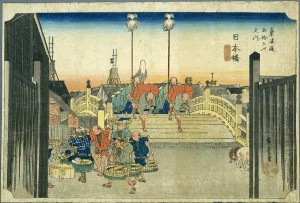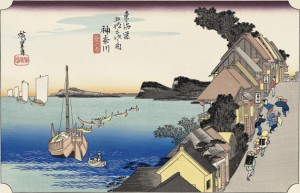Why yes, that was indeed a reference to Inception as today’s subject line. Not only is it one of my favourite movies of the year (and possibly of all time), it is entirely relevant to the kimono I received this morning. If you’re familiar with Inception, the concept of a “dream within a dream” will be very familiar to you. So imagine someone like me, who dreams of kimono regularly, finding “kimono within kimono.”
When I first saw it on eBay I was completely smitten. It is a kurotomesode (short sleeved, five-crested black formal kimono), which is definitely something I don’t need more of. However, rather than the relatively typical celebratory designs of cranes, flowers, carts, fans, etc, the pattern on this kimono is… kimono! All around the inside and outside hem of this kimono are wooden racks with kimono out to dry, as well as bowls and tools for washing. I’ve never seen anything like it, and I knew I had to have it. It ended up going for a bit more than I’d hoped to spend, but was still well worth the investment.
Both the age and the usage of this kimono are a bit of a mystery. The design is very avante-garde and non-standard for a normal woman, and the hem is slightly padded, which weigh in the favour of it being a hikizuri of some sort. The length of the kimono is also longer than average for its apparent age, but not quite long enough to be proper hikizuri. It may have been made for a particularly short geisha, or possibly just a very stylish woman. It’s hard to say. The sleeves are lined in red, which is a typical element of Taisho and early Showa era kimono, but they are slightly shorter than average for that era. The body is also lined in white, not red, but that may have been replaced at some point during its lifespan.
Update, April 22, 2012 – Naomi recently discovered the existence of a motif known as tagasode, or “whose sleeves?”
Literally, “whose sleeves?.” Painting theme depicting beautiful kimono 着物 draped across a wooden rack, ikou 依桁. The subject was usually painted on folding screens *byoubu 屏風 and became popular in the late Momoyama and early Edo periods (16c and early 17c). Although the subject is highly decorative, the word tagasode has deep literary connotations and probably originated from a line in KOKIN WAKASHUU 古今和歌集 (905): “Iro yorimo/ka koso aware to /omohoyure/tagasode fureshi/yado no ume zomo 色よりも/香こそあはれと/おもほゆれ/誰が袖ふれし/宿の梅ぞも”. Tagasode often implies a beautiful woman whose absence is missed, since beautiful sleeves are thought to evoke the image of an elegant woman and the fragrance arising from her kimono.
In early examples, typical objects belonging to a room in the pleasure quarters or even a beautiful woman herself were depicted; a screen in the Burke Collection, New York (early 17c), includes a musical instrument, koto 琴, while two young women are painted on early 17c screens in the Nezu 根津 Museum, Tokyo. Variations on the tagasode theme became more removed from literary associations, and finally the kimono and stand remains as the only motifs depicted against gold foil background. There are many examples from the Edo period, often by unknown genre artists.
source – JAANUS, tagasode
Outside view

Inside view

Outer details



Inner details


It’s absolutely beautiful up close – everything is covered in tiny and delicate patterns, from the kimono to the racks holding them up. The kimono are all outlined in gold couching thread which is in impeccable condition, no drooping or detached threads anywhere that I can find.
I seem to have a knack for finding kimono that are technically kurotomesode but have characteristics that may throw them off. My chidori and matsu hybrid kimono is another prime example. As for this piece, it may be an oddity, and I may not know who wore it or when, but I love it nonetheless.






































 Bebe Taian
Bebe Taian CHOKO Blog
CHOKO Blog Gion Kobu
Gion Kobu